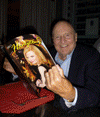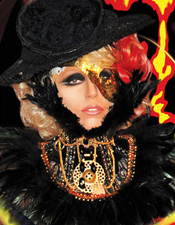|
Last Halloween, little monsters took to the city streets and infiltrated costume parties, donning ensembles so outlandish that one glance could scorch the naked eye. Every year, without fail, there is some loved or loathed character from the annals of recent pop culture that everyone under the sun masquerades as. Both relished and ridiculed for her brazen and bizarre style, Lady Gaga, who lovingly refers to her fans as “my little monsters,” spawned the most impostors by far last October 31st. And rightfully so. Her 2008 album, The Fame, produced more No. 1 Billboard Pop Songs chart singles than any other debut album ever. Tracks like “Just Dance,” “Poker Face,” “Love Games,” “Paparazzi,” and “Bad Romance” continue to be played ad nauseam around the world and have managed to transform Gaga from just another dime-a-dozen promising breakout talent into a trailblazing sartorial supernova with a pair of pipes to be reckoned with. Gaga writes all her songs and does not dabble in the low art of lip sync. But her transcendent tunes, which are an infectious mélange of electro-pop, ‘80s kitsch, and her own beguiling brand of beats, aren’t the only thing that have turned us all into self-professed monsters. Whether repelled or enraptured by her quixotic appearance, fans and naysayers alike have taken notice. With her dresses made of Hello Kitty stuffed animals and her hats fashioned from the very hair on her head, Gaga is intrusively in your face. The very sight of her is a blitzkrieg on your senses. She’s no smiling Miley. She couldn’t be more different from that sunny Taylor Swift, whose angst can hardly be called angst, it’s imparted with such puerile aplomb. She’s controversial, and we, in this age of entertainment, are smitten with controversy.
And where, pray tell, did this 23-year-old, five-foot-one fantastical creature hail from? It’s hard to think of her being part of any family aside from her gaggle of creative collaborators, producers, and designers, whom she’s christened Haus of Gaga. You’d think the parents of Lady Gaga-née Stefani Joanne Angelina Germanotta—led some alternative lifestyle—that, instead of PTA meetings, they attended transvestite rallies and hosted the occasional séance. But the family was decidedly normal in their Upper West Side abode. Her father has a business selling Wi-Fi to hotels, and her mom was in telecommunications. It’s difficult to imagine her doing anything remotely functional, like washing her face before bed. Creatures like Gaga aren’t bound by such terrestrial activities. How regular, then, that this stupendous Gaga seems to be somewhat of a daddy’s girl. At the end of 2009, Joe Germanotta underwent heart surgery, and his eldest daughter kept a bedside vigil. “I just wanted to have him walk me down the aisle and hold my babies,” she confessed to Elle.
Early on, there were explicit signs of Gaga’s precocious talent: she learned to play the piano by ear at age four, was accepted to Juilliard at eleven, and wrote her first piano ballad at thirteen. She was a self-proclaimed theater nerd at her exclusive all-girls Upper East Side Catholic School, Convent of the Sacred Heart, and at 17 she was admitted to the prestigious Tisch School of the Arts at New York University but dropped out after a year to pursue a solo career. She bumbled around for a while, had a brief liaison with cocaine, (“It was quite sick,” she recalled in an interview with Rolling Stone), joined a hard-rock band, and performed around downtown Manhattan before meeting producer Rob Fusari, who dubbed her Gaga because she reminded him of the Queen song “Radio Ga Ga.” Through him she met mega-producer Vincent Herbert, whose Streamline label exists under Interscope. He flew her to L.A. She was signed. Everything changed.
“Just Dance,” her first Grammy-nominated single, was picked up by New York and New Jersey’s lead radio station, z100, and it rocked the airwaves. A music video followed, the first of a sensational few, and Lady Gaga, the performance monster, was born in full. It wasn’t the video, filled to the brim with dancing, dolled-up lunatics, and Gaga herself dressed marvelously “Gaga,” that exposed her as the unabashed weirdo that she projects; it was, and still is, her off-stage pageantry that caused such a hubbub. Even Madonna, that long-standing queen of chameleon, to whom Gaga is constantly compared, is occasionally seen stepping out in sweats. Gaga is never not in costume. There’s no Clark Kent switcheroo once she descends the stage. At the 2009 MTV Video Music Awards, after changing out of the white-stretch, tummy-baring leotard that spouted blood on cue at the finale of her performance, she accepted the award for best New Artist wearing what looked like a red lace transparent muumuu and an almost opaque mask that completely obscured her face. She left the award show in yet another guise, a puffed-up, one-shouldered, silver space-age singlet. At an appearance on a German television show, she wore a dress made solely from sewn-together Kermit the Frog dolls. The singer gets tricked out for inane activities, too. There are photos of Gaga sauntering down the street in nothing but a sequined bra and panties, or moseying around town near her home in L.A. sporting headpieces that make Cher’s variety-show ensembles look positively demure. Is it that she has indefatigably devoted her life to playing this character? Or is she this character? Is her preference for wacko contrived, or is it true? “I am 100 percent honest in what I do and who I am, and I’ve got nothing to hide,” she said.
Wacko or not, she’s undoubtedly a rebel with a cause. During her now famous interview with Barbara Walters (where, in a rare moment of adherence to sartorial norms, she donned a relatively conservative Chanel suit out of deference to the venerable anchor), she spoke about her obligation to her fans. “I want to liberate them and free them from their fears,” she said. This much is apparent. Her priority is not to be pretty. She probably spends more time primping than anyone else in showbiz right now, but the goal is not to mimic a Vogue cover girl or even a Maxim pinup. Her elaborate composites are alienating. Masks that are more like muzzles, makeup that’s macabre, dresses that stick up and jut out in inopportune areas constitute her signature style. Although it’s hard to discern what she looks like sans all the elaborate accoutrements, one can see that Lady Gaga is no classic beauty. Her nose is formidable, she’s a bit toothy, and her body, though bodaciously fit, is not willowy like a supermodel’s. “I don’t feel like I look like the other perfect little pop singers,” she told Rolling Stone. “I think I’m changing what people think is sexy.” In other words, she’s a luminous emblem of all who are different. Straight men don’t pine after her, and women generally don’t think she’s a looker, but both genders are ensnared nevertheless. Next to this anomalous star, beauty is boring. She’s something better than beautiful: she’s explosive, she’s different, and because of this she’s enthralling. Celebrity blogger Perez Hilton described her as “exciting and dangerous. She plays by her own rules.”
Some of her most steadfast support comes from the gay community. Admittedly bisexual, Gaga is a zealous advocate of gay rights. She accepted her MTV Video Music Award on behalf of “the gays,” and at the National Equality March in DC she declared that she wouldn’t rest until homophobia ceased. When asked who her dream female hookup would be, she replied, “That’s difficult for me to answer. It trivializes being bisexual.” Gaga has lamented her forthrightness in talking about her sexual preferences, acknowledging that she doesn’t want people to think she’s trying to be alternative. The truth is that it does give her an edge. Although she’s said her song “So Happy I could Die” is about masturbating while thinking about a woman, she also told Barbara Walters, “I’ve only been in love with men, I’ve never been in love with a woman.” In the same interview, she admitted that she has had “sexual relations with women,” and on Friday Night with Jonathan Ross, which aired on BBC One, she described the hit “Poker Face” as being about “pokerfacing” your sexuality: “When I was making love to my old boyfriend I used to think about women sometimes,” she said. As if her sexual ambiguity weren’t rousing enough, performance photos of a tell tale bulge between her legs surfaced. Rabble-rousers denounced her a hermaphrodite. Gaga’s response? She didn’t dispute the accusation; she coolly explained that she had been wearing puffy undies. What’s so terrible about being a hermaphrodite? she seemed to be saying.
Many artists, despite the phenomenal gift of song, don’t say very much. But it is her voice and the story she imparts with it that Gaga values most. “I find that men get away with saying a lot in this business, and that women get away with saying very little,” she told the LA Times. She is not one to fall prey to the silence bug. There is always meaning in Gaga’s songs, in her intricate videos. In “Bad Romance,” she wears a strange and confining white patent-leather bodysuit that envelopes her face. She’s shown as an emaciated creature with the spokes of her spine jutting out from beneath her skin. Other odd, seemingly non sequiturs abound: kidnappers force vodka down her throat; the camera pans to a yawning hairless cat; and in the last minute Gaga sings the powerful refrain with added vehemence, as she dances in a skimpy suit of red bandages. It looks good all right, but it’s utter chaos, this video. At approximately five minutes and eight seconds, it is also a poignant narrative. It’s a social commentary on the impossible expectations that the media impose on the female form. It is, as Gaga has said, about “how the entertainment industry can, in a metaphorical way, stimulate human trafficking—products being sold, the woman perceived as a commodity.” Each of her videos is a different chapter in the saga of Gaga. Her music, her visual renditions, her performances all stand for something. As she told Walters, “The truth is that every bit of me is devoted to love and art.” You wouldn’t think that someone so cutting-edge would subscribe to the hackneyed saying that love makes the world go round. But she does. Lucky for us, she wears her heart on her sequined sleeve. [HS]





